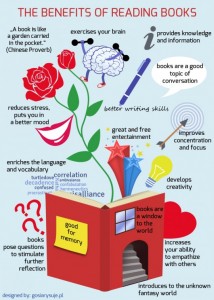 How much of their leisure time do teenagers devote to reading? Not much. According the Bureau of Labor Statistics, teens read for pleasure, on average, just six minutes each day. Why?
How much of their leisure time do teenagers devote to reading? Not much. According the Bureau of Labor Statistics, teens read for pleasure, on average, just six minutes each day. Why?
Attitudes toward reading are one factor, but not the only factor. (Consider that, because we’re talking about reading the child freely chooses, she must not only like reading, she must like it more than the other available choices. I’ll have more to say about that on Friday.) Attitudes toward reading peak in early elementary years. With each passing year, students’ attitudes towards reading drop.
It’s not hard to see why that might happen. For most children, learning to read is rewarding; it’s a sign of getting older, of gaining a skill that older siblings and friends possess. The emphasis in those early years is on understanding and appreciating stories. But consider how reading changes in the mid-elementary years and beyond.
Higher expectations for comprehension: stories become longer and more complex. A page from a book for first-graders might be a picture with a sentence or two of text. By third grade, students are expected to read chapter books like Charlotte’s Web.
Less choice: As kids get older, they are confronted with more texts they must read, and less often have the option to replace a book they aren’t enjoying with something else.
More genres: Early elementary students read mostly stories, a genre familiar to many from read-alouds, movies, and television. Later they encounter biography, news stories, and other genres with different organizations and conventions. The novelty of the genre makes comprehension harder.
Different purposes: Perhaps most important, teachers ask students to put reading to new purposes. Younger children read to comprehend and enjoy a narrative. Older children might read to locate specific facts during research. Or they read to learn and remember material for a quiz.
Curiously, attitudes towards reading drops not only for the reading that students do at school, but also for reading they do at home (McKenna et al, 1995).
Why would attitudes toward leisure reading drop?
One possibility is that students don’t differentiate among different types of reading (Gallagher, 2009). They perceive that the reading they are required to do for school feels like work, not a leisure activity. And that feeling changes their attitude towards leisure reading.
If students do not make a distinction between reading for pleasure and reading that is not optional, that must be completed, and that usually has other assignments associated with it, why not make this distinction clear to them?
Obviously I’m not suggesting that teachers present assigned reading as drudgery. Rather, the message might be that reading for leisure includes more options than reading for school. You can skip parts that seem slow. You can peek at the ending. You can drop books at your whim. You can read only in the genre that pleases you, be it biography, horror, manga, or technical diagrams of heavy machinery. The litmus test for any text and any manner of reading is whether it brings you pleasure.
Teachers are well practiced in answering the querulous question “Why do we have to do this?” It may be worth emphasizing to students how much they might enjoy the reading that they don’t have to do.
Source: http://www.washingtonpost.com/blogs/answer-sheet/wp/2015/04/29/why-kids-lose-interest-in-reading-as-they-get-older/
